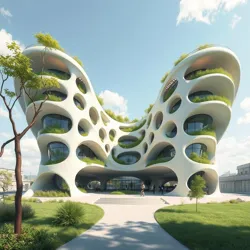Biomimetic Designs
Biomimetic designs are innovative approaches in engineering and architecture that draw inspiration from the natural world to solve complex human problems. By emulating the structures, processes, and systems found in nature, biomimetic designs aim to create more sustainable and efficient solutions across various industries.

Biomimetic architecture takes inspiration from natural forms and processes.
Historical Background
The concept of biomimetics can be traced back to ancient times when humans first observed and imitated nature. However, the term "biomimetic" was popularized in the 20th century by scientists and engineers, particularly as technological advancements enabled more precise replication of biological principles. The field has since expanded to include a wide range of applications, from material science to robotics.
Notable Early Innovations
One of the first significant biomimetic innovations was Velcro, inspired by the way burrs adhere to animal fur. This simple yet revolutionary fastening system demonstrated the potential of biomimetic design to offer practical solutions.
Key Principles
Biomimetic designs are grounded in several core principles:
- Nature as Model: Observing and understanding natural systems to inspire new designs.
- Nature as Measure: Evaluating the sustainability and efficiency of designs by comparing them to natural benchmarks.
- Nature as Mentor: Using nature as a guide for developing innovative solutions without harming the environment.
Applications
Biomimetic designs have found applications in numerous fields:
Architecture and Urban Planning
Architects use biomimetic principles to design buildings that are more energy-efficient and environmentally friendly. For example, the structure of termite mounds has inspired passive cooling systems in architecture, reducing the need for artificial air conditioning.
Material Science
In material science, biomimetic designs have led to the development of stronger, more durable materials. The study of spider silk, for instance, has inspired the creation of lightweight yet incredibly strong fibers used in a variety of applications.
Robotics
Biomimetic robotics seeks to replicate the movement and functionality of organisms. For instance, robots designed to mimic the locomotion of geckos or octopuses are used for tasks that require agility and adaptability, such as exploration or search and rescue missions.
Ethical and Environmental Considerations
The adoption of biomimetic designs raises important ethical and environmental considerations. While these designs often promote sustainability, there is a need to ensure that the exploitation of natural systems is conducted responsibly and ethically. Researchers advocate for the careful balance between innovation and conservation to avoid disrupting ecosystems.
Future Directions
The future of biomimetic designs is promising, with ongoing research focused on integrating more sophisticated biological principles into technology. Advances in fields like Neural Interface Engineering and Silico-Biological Fusion are expected to further expand the possibilities of biomimetics, potentially leading to breakthroughs in areas such as cognitive augmentation and environmental rehabilitation.
See Also
- Neural Interface Engineering
- Silico-Biological Fusion
- Cognitive Augmentation
- Environmental Rehabilitation
- Biomimetic Materials
Biomimetic designs exemplify the potential of learning from nature to create innovative solutions that are both effective and environmentally responsible. As technology continues to advance, the lessons and inspiration drawn from the natural world will play an increasingly vital role in shaping the future of design and engineering.